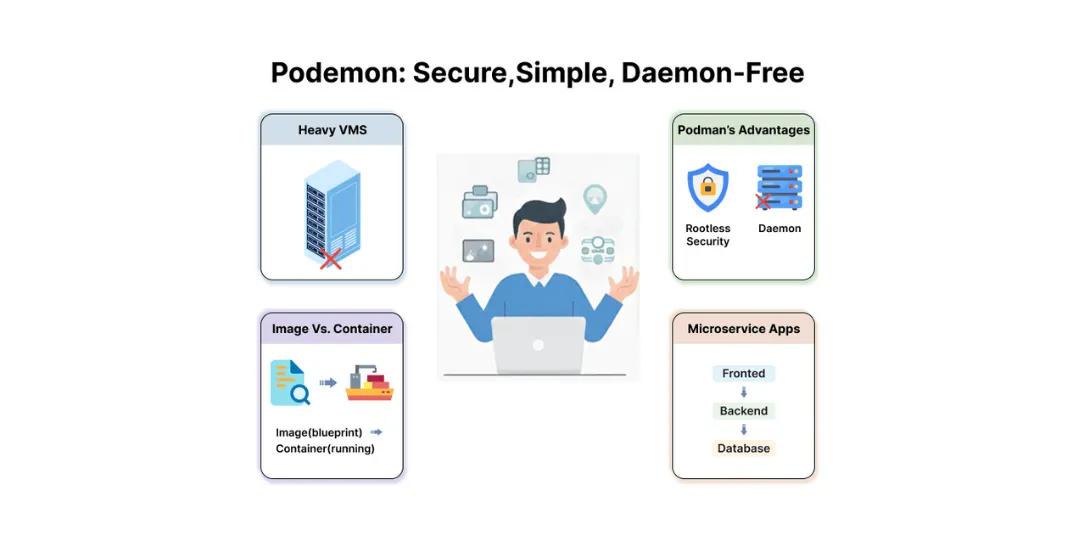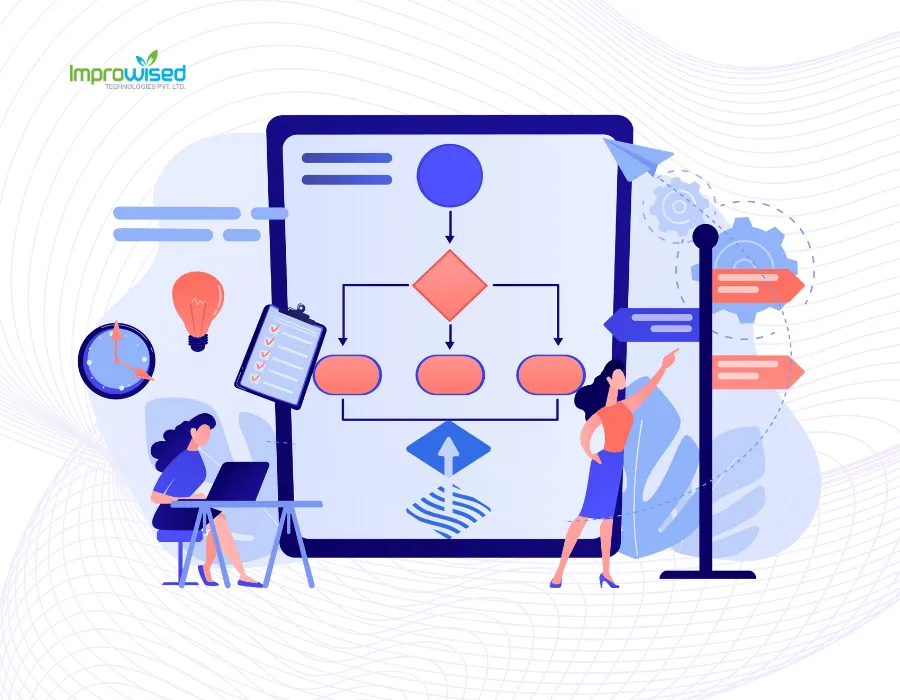July 14, 2025
Podman: A Rootless and Secure Alternative to Docker for Modern Containerization

By Chintan Viradiya
Improwised Technologies Pvt. Ltd.
What is Podman?
Podman is a tool to build, run, and manage containers. Containers let you package your app along with everything it needs (like libraries and dependencies) so it can run anywhere on your computer, on a server, or in the cloud.

Why Podman?
-
No central daemon: Docker runs a background service (called a daemon). Podman doesn’t need to run a daemon.
-
Rootless containers: Podman can run containers without needing admin (root) access.
-
Docker-compatible: Most Docker commands work the same in Podman
-
Lightweight and efficient container management.
VM vs Container
Let’s understand the difference between virtual machines (VMs) and containers:
Virtual Machines emulate entire operating systems, while containers share the host OS kernel and isolate application processes, making them more lightweight and efficient.
| Feature | VM | Container |
|---|---|---|
| Boots OS | Yes (full OS) | No (shares host OS) |
| Size | Large | Small |
| Start time | Slow | Fast |
| Isolation | Strong (full system) | Lightweight (process-level) |
Containers are faster and use fewer resources than VMs, making them perfect for development and microservices.
Podman Architecture
-
No daemon: Each command runs independently.
-
Rootless support: Runs as a normal user without admin rights.
-
Uses runC: The same container runtime used by Docker.
Installing Podman
Podman works on Linux, macOS, and Windows. Here’s how to install it:
On Linux:
Debian/Ubuntu:
sudo apt install podmanFedora/RHEL:
sudo dnf install podmanArch Linux:
sudo pacman -S podmanOn macOS:
Download and install Podman Desktop.
Or install using Homebrew:
brew install podman
On Windows:
Download and install Podman Desktop.
Verify podman is installed:
podman --version
Images and Containers
-
Image: A snapshot or blueprint of your app.
-
Container: A running instance created from an image.
For example, if an image is like a plan of Home/Company, a container is the actual Home/Company.
You can pull an image and run it like this:
# Pull httpd image
podman pull httpd
# Run that image
# -d: Run container in background and print container ID
# -t: Allocate a pseudo-TTY for container
# -p: Publish a container's port, or a range of ports, to the host
podman run -dt -p 8080:80/tcp docker.io/library/httpd
# List the running containers
podman ps
Basic Podman Commands
Here are a few common commands to get you started:
podman images # List downloaded images
podman ps # List running containers
podman ps -a # List all containers
podman run -it ubuntu # Run a container interactively
podman stop <id> # Stop a container
podman rm <id> # Remove a container
What is a Containerfile?
A Containerfile (or Dockerfile) is a text file with instructions to build a container image.
Example:
Containerfile:
FROM improwised/php-base:8.2-s6
RUN mkdir -p /app && chown -R nginx:nginx /app
COPY composer.* /app/
WORKDIR /app
RUN php -d memory_limit=1024M /usr/bin/composer install --no-scripts --no-autoloader
COPY . .
RUN php -d memory_limit=1024M /usr/bin/composer dump-autoload --optimize
Build and run it with Podman:
podman build -t laravel-horizon .
podman run -it --rm -p 9000:9000 --name laravel-horizon --env-file .env laravel-horizon
/bin/sh -c "set -e && php artisan serve --host 0.0.0.0 --port 9000"
Podman Compose
If your app has multiple containers (like a frontend + backend + database + redis…), use Podman Compose.
Example:
container-compose.yml
services:
db:
image: mysql:8.0
cap_add:
- SYS_NICE
restart: always
environment:
- MYSQL_DATABASE=quotes
- MYSQL_ROOT_PASSWORD=mauFJcuf5dhRMQrjj
ports:
- '3306:3306'
volumes:
- db:/var/lib/mysql
phpmyadmin:
depends_on:
- db
image: phpmyadmin
restart: always
ports:
- "8090:80"
environment:
PMA_HOST: db
MYSQL_ROOT_PASSWORD: mauFJcuf5dhRMQrjj
volumes:
db:
driver: local
Run it with podman-compose:
podman-compose up
Local Development with Podman
Podman is great for local development:
-
No root needed
-
Create a dev environment that mimics production
-
Easy to test apps before deploying to servers
Example:
An e-commerce developer can use Podman to locally run a React frontend, Node.js backend, PostgreSQL, and Redis, all in separate containers. This allows testing the full stack without installing any services on their system. Podman’s rootless mode ensures a secure, clean, and production-like local environment.
Podman Networking
By default, Podman containers are isolated. But you can expose ports or connect containers:
podman run -p 3000:3000 my-app # Expose port
-
Supports bridge, macvlan, slirp4netns (rootless), and more.
-
Uses Netavark (default for rootful)
To create a custom network:
podman network create improwised
podman run --network=improwised ...
Podman Volumes
You can use volumes or bind mounts to persist data.
- Volumes: Managed by Podman. Stored in
~/.local/share/containers/storage - Bind mount: Link to a folder on your host system.
Key Difference: Volumes are more portable and safer; Bind Mounts provide direct access to host paths.
Example:
# Volume
podman volume create improwised-data
podman run -v improwised-data:/data my-app
# Bind mount
podman run -v /home/user/data:/data my-app
Use volumes when you want Podman to manage storage. Use bind mounts for full control.
Use Case: One Company Secures Multi-Tenant Environments
Problem:
A web hosting company runs applications for multiple clients on shared servers. Using Docker means all containers rely on a single root-level daemon. If the Docker daemon is compromised, all containers (across clients) are at risk.
Solution with Podman:
They switch to Podman, which supports running containers without root privileges. Each client’s applications are now run in rootless containers, isolated under their respective user accounts.
Benefits:
- Even if one container is compromised, it cannot access other containers or host system files.
- No central daemon means no single point of failure.
- The setup aligns better with multi-tenant security best practices.
Summary
-
Podman is a secure, Docker-compatible container tool that runs without a central daemon and supports running containers as a non-root user (rootless), making it ideal for local development and scripting.
-
It supports all core container features: images, volumes, networking, and multi-container apps via Podman Compose.
-
You don’t need to install anything on your local machine to run the demo. Just run
podman-compose up, and you are good to go. -
This keeps your system clean and less resource-intensive.

December 12, 2025
Continuous Deployment with FluxCD: Architecture, Flow & Best Practices

By Shyam Kapdi
Improwised Technologies
Pvt. Ltd.

December 10, 2025
CI with GitHub Actions: End-to-End Pipeline Setup Guide

By Shyam Kapdi
Improwised Technologies
Pvt. Ltd.

December 5, 2025
Separating CI and CD: The Key to Faster, Safer Delivery

By Shyam Kapdi
Improwised Technologies
Pvt. Ltd.
Optimize Your Cloud. Cut Costs. Accelerate Performance.
Struggling with slow deployments and rising cloud costs?
Our tailored platform engineering solutions enhance efficiency, boost speed, and reduce expenses.
